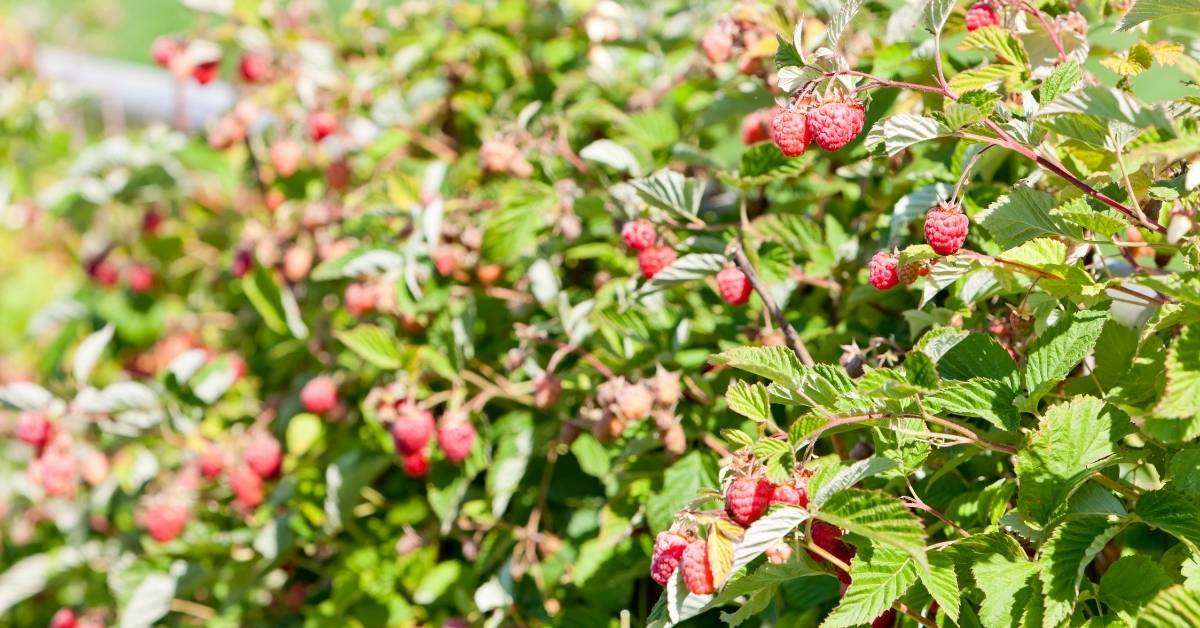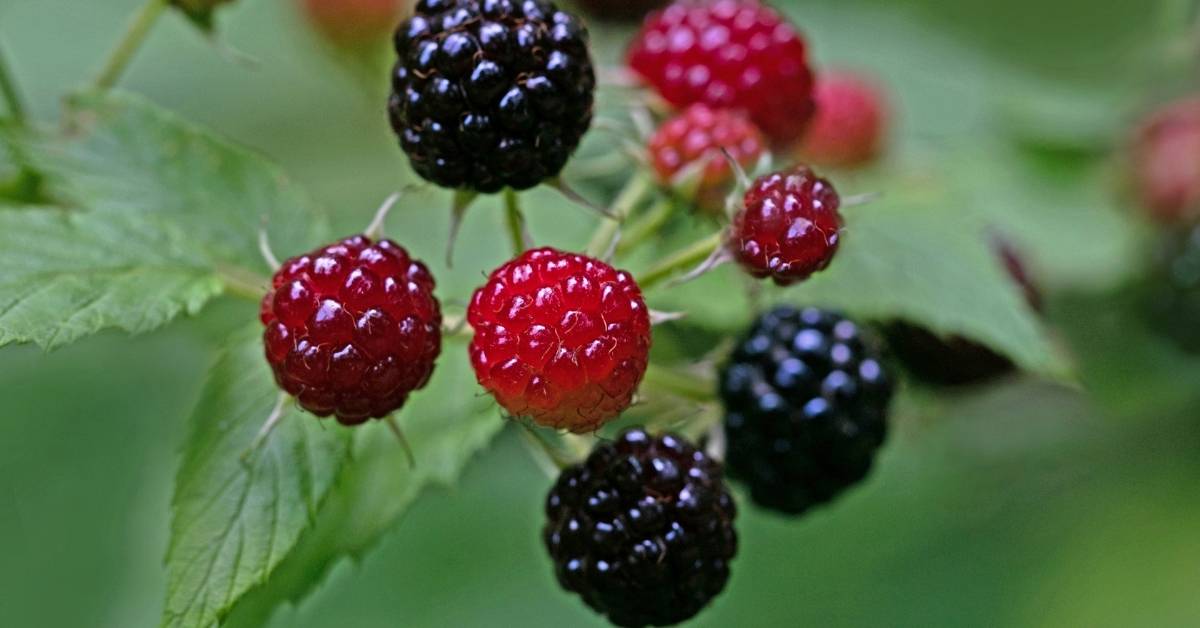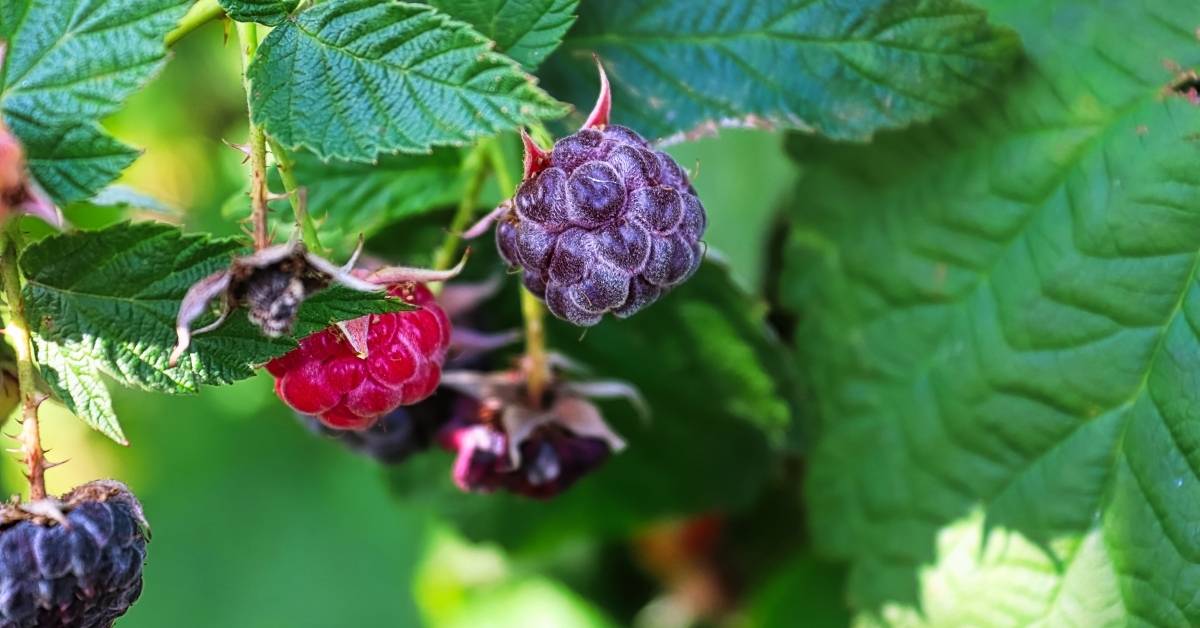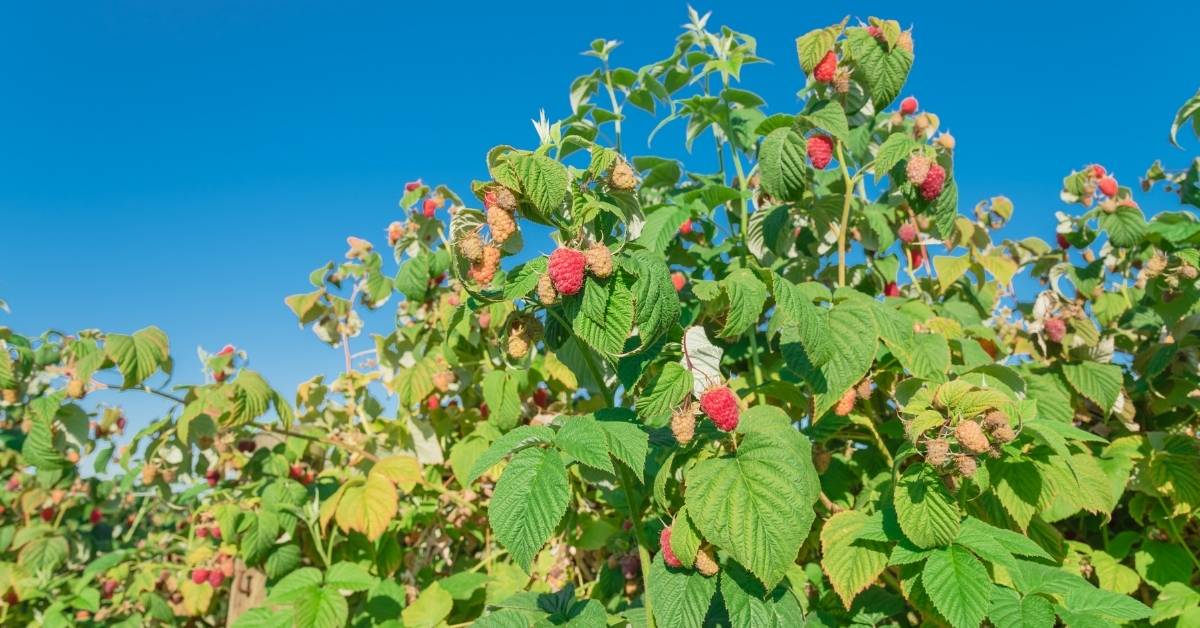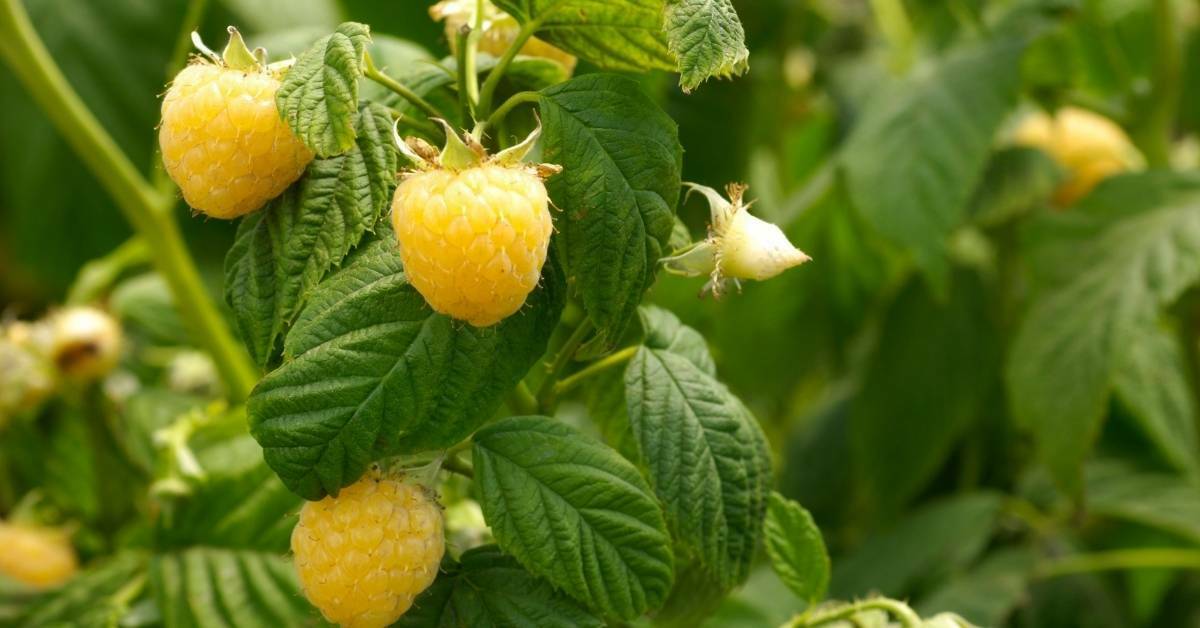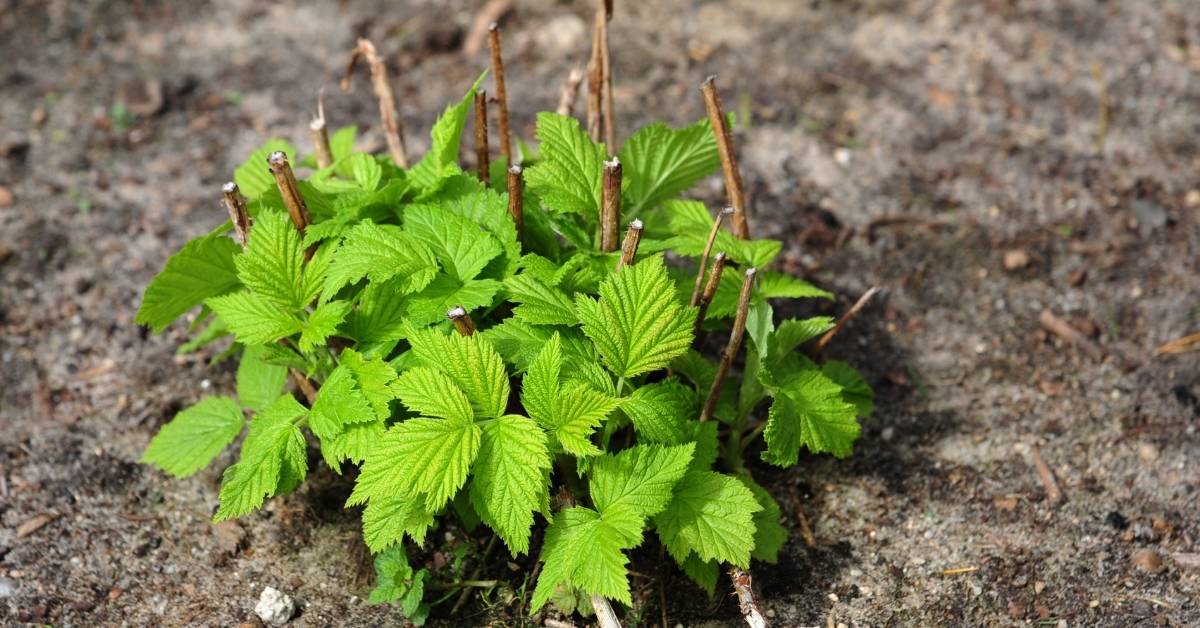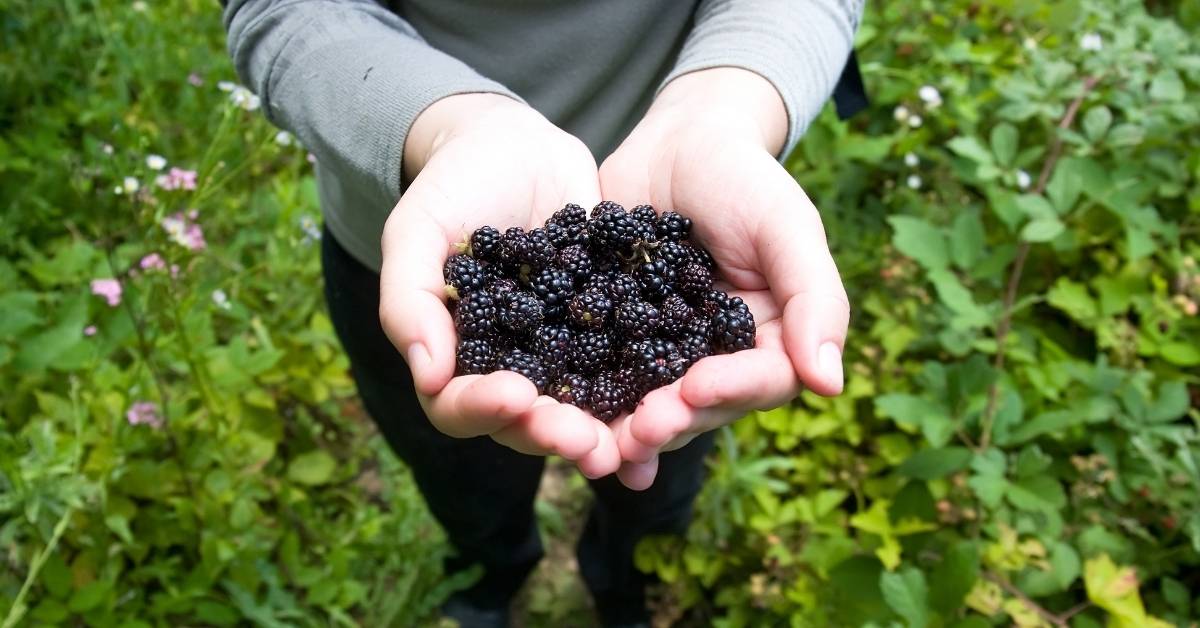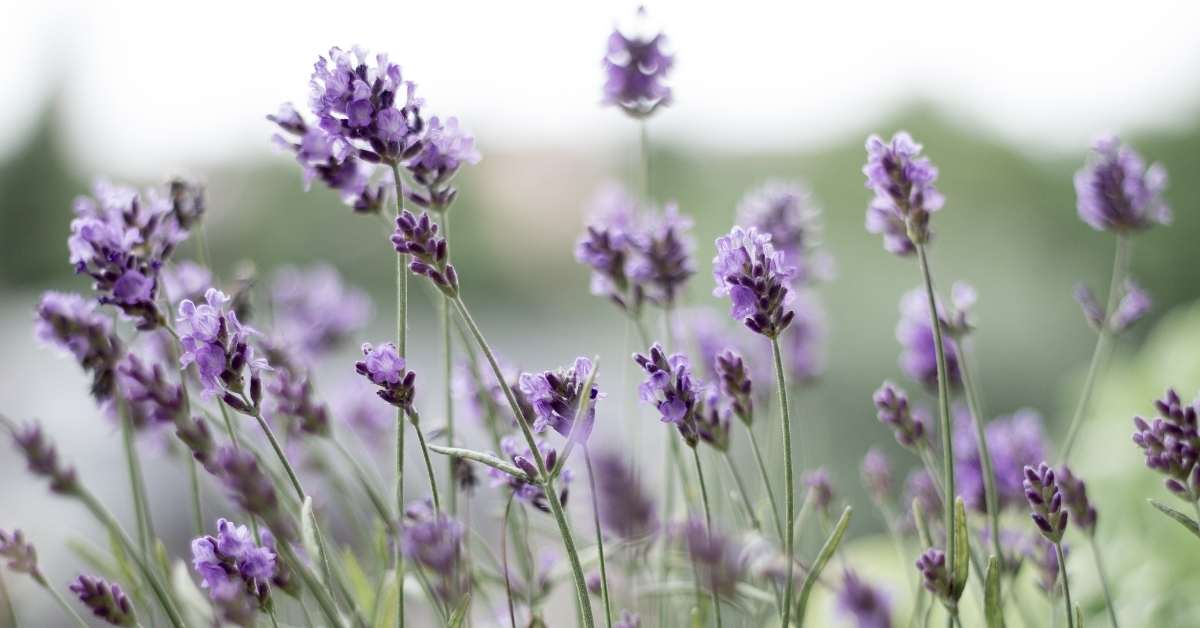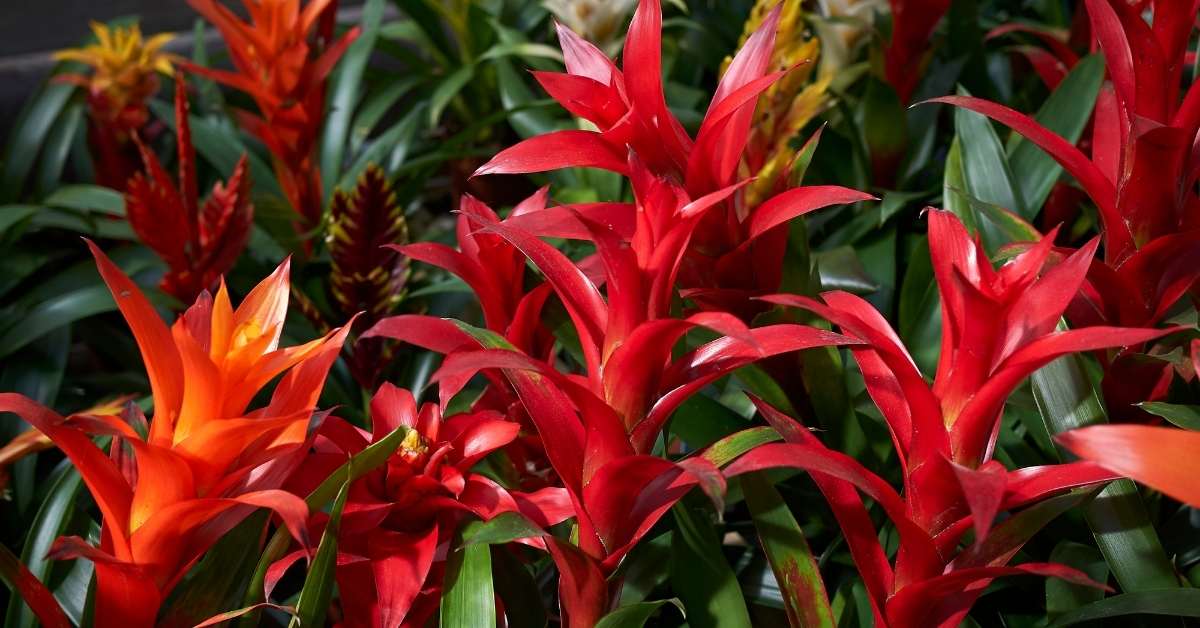Raspberry (Rubus idaeus) is a highly nutritious fruit and has a rich content of iron, folate and Vitamin C; however it is devoid of sodium, fat and cholesterol. This fruit is mainly available in two types; red and black which are commercially grown. It generally fruits in the second year of its plantation.
Because of its rich nutritional content, some of us you take interest in gardening prefer growing raspberries in their homes itself.
If you are one of curious gardeners, then this article will certainly help you by providing you with useful tips on the growing procedure. Keep reading to learn about history and varieties of raspberries, How to grow and care about them.
History of Raspberry plant
With a long history in Europe and America, red raspberries have been a favorite among consumers from Medieval times.
Several hybrids have been cultivated, to the point that today there are several hundred different cultivars, and more than 20 are cultivated in Washington alone!
Red raspberries are a very nutritious fruit that not only tastes delicious but also has a high amount of health-promoting phytonutrients, including ellagic acid and anthocyanins, as well as antioxidants and dietary fiber.
In addition to this, they are effortless to cultivate in your backyard (raspberry plants are extremely aggressive and can easily take over an entire garden if left unchecked, so you should have no problem growing several bushes).
Of the different cultivars, Rubus idaeus thrives in the relatively cool climate of the Pacific Northwest, where they are produced in a region extending from Salem, Oregon, to the Fraser Valley, British Columbia.
Raspberry production has been steadily increasing since 1800. In modern times, growth has accelerated, thanks to the introduction of highly efficient mechanical harvesters that eliminated the need for manual labor.
This, coupled with the fact that raspberry plants can produce fruit for decades, has led to a constant increase in production that met at least an equal increase in demand due to the increasing popularity of this fruit as a health supplement and addition to foods.
Other cultivars are grown east of the Cascade, where high temperatures often lead to more small plants and less fruit: the most successful sites in this region are Yakima and Spokane (because of the relatively cooler climates).
One of the reasons for their success is the fact that raspberries are self-pollinating, meaning that pollen is transferred by bees to the same plant it came from, removing the need for a male and a female plant.
Despite the numerous raspberry varieties, we can identify two distinct groups of plants: summer and fall-bearing. They’re both cultivated in the Northwest, but their features and fruiting times are vastly different.
In August-September, summer-bearing plants flower on primocanes (meaning “first-year canes”), then rest for the winter, blooming and fruiting the following spring. Canes die after this, but new canes called “floricanes” begin flowering during primocane fruiting and keep the plant alive for the following year.
Fall bearing plants also called everbearing, bear fruit on primocanes from August to September, rest in winter, then produce a second set of fruit from June to July.
Raspberry Plant Varieties and Cultivars
Floricane
Floricane raspberry plants produce berries on the canes prior year of growth. They carry one crop of berries on the over-winter canes during the summer months. The plants begin to fruit early in the summer, usually in June or July, depending on the climate and seasonal weather.
The season lasts approximately 4-5 weeks. The season for Floricane raspberry plants is generally June 15 to August 15, depending on climate and spring weather conditions.
Floricane raspberry plants are also known as summer fruiting plants.
Primocane
Primocane raspberry plants produce berries on the canes’ current year of growth. They can produce 2 crops. The largest is in the late summer/early fall. The fruit grows on the tips of canes that grow throughout the summer. A second crop grows the lower portion of those same canes early the following summer.
In order to have two crops, the plant must be pruned as a summer bearer. Most primocanes will produce the best crop if NOT allowed to fruit in the early summer.
Primocanes are preferred if you wish to have a fall crop (late August to October).
Primocane raspberry plants are also known as fall fruiting or everbearing.
This list is by no means complete, but it offers good insight into several common cultivars. Credits go to several U.S. universities, including Cornell and Maryland, for providing the necessary information.
Early Season
- Boyne (Manitoba, sibling to Killarney) plants are spiny and produce many suckers. The fruit is tiny to medium in size, dark and soft, and ripens early, yet it has an excellent flavor and freezes well. It is pretty hardy in the winter, although it is vulnerable to anthracnose. Late yellow rust resistance is modest, and it is tolerant of Phytophthora root rot and crown gall, although it is vulnerable to raspberry fireblight. Boyne has excellent yields and is suggested for use in cooler regions.
- Killarney* (Manitoba, sibling of Boyne) has short to medium canes, is spiny, and produces many suckers. Phytophthora root rot resistance is modest. Mildew and anthracnose are two diseases that might affect it. The fruit ripens earlier than Prelude and Boyne but after Prelude and Boyne. The fruit is average in size; however, it is very brilliant red and crumbles easily. The flavor and freezer quality is outstanding; however, warm temperatures may cause the berries to soften. This variety is extremely hardy and is best used in cooler regions.
- Prelude* (Cornell University-NYSAES, Plant Patent #11,747) is the earliest summer fruiting cultivar available. The fruit is medium in size, round and solid, and has a pleasant flavor. It has high winter hardiness and is resistant to Phytophthora root rot. A modest fall yield is substantial enough to justify two harvests. It is probably the best early-season cultivar available for the Northeast.
Mid Season
- Canby* (Oregon) canes are tall, nearly spineless, and moderately productive. The fruit ripens in the middle of the season, is medium to big in size, firm, and bright red in color, and has a great flavor. It has moderate or poor hardiness, and buds in cold regions may winter death. Phytophthora root rot is a problem for it.
- Claudia (KCE-1, University of Maryland, Patent pending) generates canes that are strong and erect. The fruit is big and conical in shape, with a pleasant flavor that ripens in the middle to late season. It’s typical to harvest in the late fall. It is cold hardy enough for most climates. This is a new release that has done well in Geneva despite its inexperience.
- Emily (JAM-1, University of Maryland, Plant Patent #12,350) is a big midseason fruiting plant with high production potential. It’s vulnerable to Phytophthora root rot and has a low tolerance for cold. This is a brand-new release that has yet to be tested and fared miserably in Geneva.
- Esta (GEL-114, University of Maryland, Patent pending) yields big, conical fruit with a weak, bland flavor in the middle to late season. It’s prone to Phytophthora root rot and isn’t cold tolerant. Leafhoppers aren’t a problem for it. It requires trellising to make picking easier. This is a fresh release that hasn’t been thoroughly tested.
- Nova (Nova Scotia) is vigorous and upright with long, fruiting laterals. There aren’t many spines on the canes. The fruit is medium in size, brilliant red, firm, and somewhat acidic when it ripens in the middle of the season. It is said to have a longer shelf life than usual. The plants appear to be resistant to most major cane diseases, including rust. It will produce a late-season harvest.
- Titan* (Cornell University-NYSAES, Plant patent # 5404) develops giant canes with few spines and suckers that primarily originate from the crown; thus, it spreads slowly. It’s prone to crown gall and Phytophthora root rot, although it’s a high-yielding plant. Fruits are exceptionally big, dull crimson, and mildly flavored when they mature in the middle to late season. Picking berries is tough until they are fully ripe. Titan is a moderate climate plant with just fair hardiness. It is resistant to the mosaic virus complex’s raspberry aphid vector.
Late Season
- Encore* (Cornell University-NYSAES, Plant patent # 11,746) is one of the most recent summer-fruiting raspberry varieties on the market. It yields berries that are big, solid, and somewhat conical in shape, with a sweet flavor. The fruit is regarded to be of excellent quality. It has high cold tolerance and is somewhat sensitive to Phytophthora root rot.
- K81-6 (Nova Scotia) produces medium-sized canes with only a few spines at the base. The fruit is big and flavorful, ripening late in the summer with medium firmness. Late yellow rust resistance exists; however it is vulnerable to leaf curl virus and raspberry fire blight. For the most part, hardiness is deemed acceptable.
Black Raspberry Plants
Description
The Black Raspberry Plant, Rubus occidentalis, is native from the Northeast to the Great Plains. The native western black raspberry, or “blackcap,” is R. leucodermis.
Black raspberry plants produce canes only from the crown, not from the roots. Tip the primocanes in the summer to encourage branching. The following year, these canes produced fruit.
There were hundreds of black raspberry varieties in the early 1900s, and new cultivars were developed until the 1960s. Since then, relatively little breeding effort has been made on black raspberries, and just a few varieties are currently widely accessible. Almost majority of the commercial crop in the Northwest is “Munger,” a cultivar introduced in 1890.
Black Raspberry Cultivars
- Allen Black Raspberry
- Season – Early to mid-summer
- Fruit Size – Large
- Origin – New York
- USDA Zone – 5-8
- Black Hawk Black Raspberry
- Season – Midsummer
- Fruit Size – Medium-Large
- Origin – Iowa
- USDA Zone – 5-9
- Bristol Black Raspberry
- Season –
- Fruit Size – Medium-Large
- Origin – New York
- USDA Zone – 5-8
- Cumberland Black Raspberry
- Season – Mid to late summer
- Fruit Size – Large
- Origin – Pennsylvania
- USDA Zone – 5-9
- Haut Black Raspberry
- Season – Early
- Fruit Size –
- Origin – Maryland
- USDA Zone – 5-8
- Jewel Black Raspberry
- Season – Early to mid-summer
- Fruit Size – Medium-Large
- Origin – New York
- USDA Zone – 5-8
- Munger Black Raspberry
- Season – Midsummer
- Fruit Size – Large
- Origin – Ohio
- USDA Zone –
- Bristol (Cornell University-NYSAES) is a robust and high-yielding black raspberry variety, especially when young. The fruit is medium to big and firm, with great flavor, and ripens early. Bristol is a robust black raspberry variety; however, it should be checked to verify that it is hardy enough. It’s sensitive to anthracnose and raspberry mosaic complex, but powdery mildew doesn’t bother it.
- Jewel* (Cornell University-NYSAES) is vigorous, erect, and productive for black raspberry. This cultivar seems to be more disease resistant than others, and it also has anthracnose resistance. The fruit is solid, glossy, and delicious when ripe, and it ripens in the middle of the season. This cultivar of black raspberry is a hardy variety.
- Mac Black is a newcomer to the scene who has yet to be really tested. It’s a late-season black raspberry that produces medium-sized berries. For a black raspberry, it is said to have good cold tolerance. Definitely worth a try if you want to extend the harvest of your black raspberries by 7-10 days.
Bristol Black Raspberry Plant
The Bristol Black Raspberry cultivar was released in New York. It is a licensed variety of Cornel University. It produces firm, juicy berries with a true black raspberry flavor. Berries are ready in late June to mid-July for harvest and don’t leak when picked. Berries are easy to pick fruit due to the plant’s upright growing tendency. Plants are vigorous, extremely hardy, and high-yielding. Zones 4-8
Bristol is the ideal variety for canners and jelly makers. Berries are also suitable for freezing and canning. Bristol is said to be the best-tasting black raspberry.
Bristol black raspberry plants have shown to be tolerant of powdery mildew and susceptible to anthracnose. Plants prefer full sunlight and grow best in fertile, non-alkaline soil. It is also best to have well-drained soil.
Details
- Zones: 4 – 8
- Ripening Date: early July in zone 6
- Height: 3-4 Feet
- Spread: 3-4 Feet
- Sun Level: Full sun
- Fruit size: Medium to large
- Taste: Excellent, Rich
- Texture: Firm
- Color: Black
- Hardiness: Extremely hardy
Purple Raspberry Plants
Description
The purple raspberry is a cross between black and red raspberries. They’re usually tall, crown-forming plants with big, soft fruit. Purple raspberries are typically regarded as having just mediocre quality when used fresh but are outstanding when processed. Purple raspberry plants tend to respond in growth habits similar to black raspberry plants.
Purple Raspberry Cultivars
- Brandywine Purple Raspberry
- Season – Late summer
- Fruit Size – Large
- Origin – New York
- USDA Zone – 3-?
- Royalty Purple Raspberry
- Season – Late summer
- Fruit Size – Large
- Origin – New York
- USDA Zone – 4-7
- Success Purple Raspberry
- Season – Mid to late summer
- Fruit Size – Small
- Origin – New Hampshire
- USDA Zone –
- Brandywine (Cornell University-NYSAES) develops tall canes with pronounced thorns, and suckers only grow from the top, preventing the plant from spreading. Crown gall is a problem, but it’s also prone to a variety of other illnesses. Fruits are big, dull reddish-purple, and acidic, ripening later than other red varieties. The best berries to utilize for processing are berries. This variety produces a lot of fruit.
- Royalty* (Cornell University-NYSAES, Plant patent # 5405) is considered the best purple raspberry available. The canes are tall, robust, and thorny, and they produce a lot of fruit. The large raspberry aphid is resistant to royalty, which reduces the risk of mosaic virus infection, but it is sensitive to crown gall. When completely mature, the fruits are big and reddish-purple to dull purple in color. When eaten fresh, berries are delicate but sweet and delicious. It’s ideal for processing. For northern growing regions, hardiness is acceptable.
Fall Bearing
Autumn Bliss Raspberry Plant
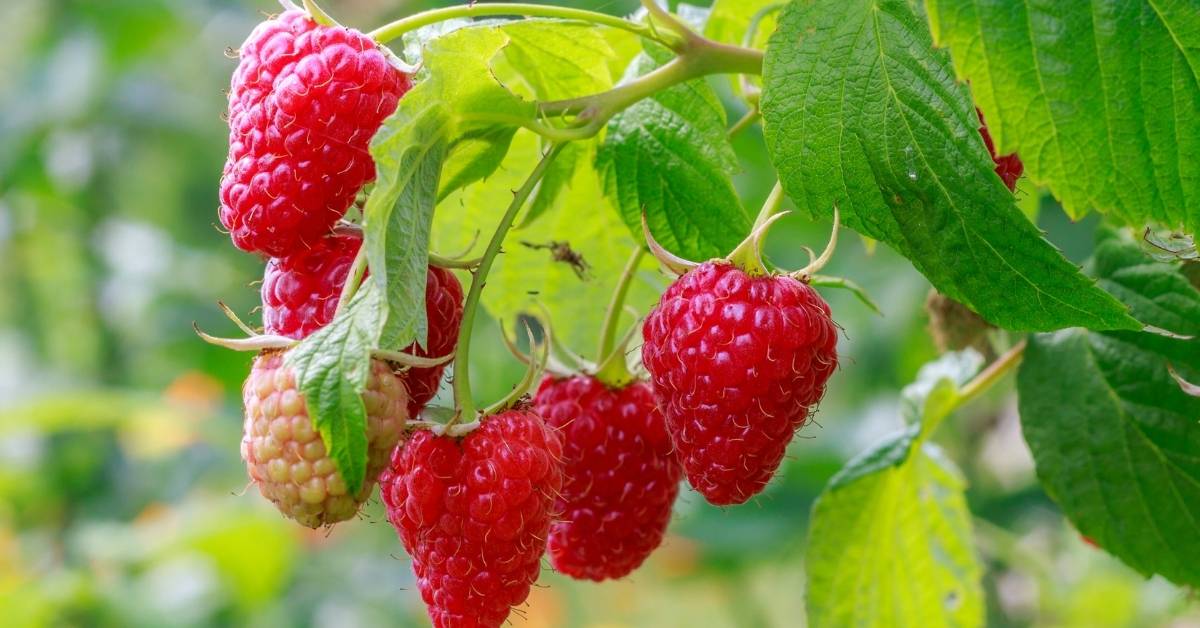
Autumn Bliss raspberry plant is an early ripening raspberry with large, highly flavored fruit. Large fruit is attractive dark red with a mild flavor and an oval-conical shape. Fruit can be somewhat soft but firm enough to pick easily. It produces high yields.
This cultivar produces short, sturdy, fairly erect primocanes with numerous light purple spines. Canes do not need any support to grow but do well when used with a trellis system. Plant crowns 18 inches apart. After fruiting, canes can be cut to ground level.
Autumn Bliss has shown a strong annual consistency and resistance to foul weather and heat. A large portion of the crop is harvested within the first two weeks, which is advantageous in northern climes. This cultivar is one of the best and most dependable types for fall fruiting.
It produces a heavy crop of berries, approximately 50% of its total yield during the first three weeks of harvest. This helps ensure a good crop even in the event of an early freeze. This early production season can help close the gap between summer-bearing raspberries and fall-bearing. Autumn Bliss ripens 10 to 14 days before Heritage and before Caroline and Himbo Top.
Autumn Bliss has been shown to be resistant to aphids and to root rot. It is susceptible to the raspberry bushy dwarf virus.
Details
- Type: Primocane (Fall) Fruiting
- Date: Everbearing
- US Plant Patent: PP06597
- Designation: Complex parentage, including Rubus strigosis, R. arcticus, R. occidentalis, and 6 red raspberry varieties
- Zones: 3-9 (-20F)
- Height: 4-5 Feet
- Spacing: 3 Feet
- Depth: Below the crown
- Spread: 4 Feet
- Sun Level: Full or Part Sun
- Pollinator: Self-pollinating
- Color: Dark red
- Fruit Size: Large fruit
- Fruit Shape: Oval conic
- Taste: Highly flavored, mild
- Texture: Somewhat soft
- Yield: High
- Anne (University of Maryland, Plant patent # 10,411) produces large, conic, pale yellow fruit with excellent flavor and texture in the mid to late season. It produces tall upright canes, but it lacks the suckering ability to make nice stands. It is Phytophthora root rot resistant.
- Autumn Bliss (Great Britain, Plant Patent #6597) is a big, highly flavorful raspberry that ripens early. It takes 10 to 14 days for it to mature before Heritage. A large portion of the crop is harvested within the first two weeks, which is advantageous in northern climes. It develops canes that are short and have few spines. The fruit has a black color to it. Raspberry bushy dwarf virus can infect it.
- Autumn Britten* (Great Britain) has big, firm, well-flavored fruit that ripens early. It’s a little higher than Autumn Bliss, with somewhat lower yields but superior fruit quality. Autumn Bliss is a day or two behind it.
- Caroline* (University of Maryland, Plant patent # 10,412) is a large, good flavored, conical fruit. It produces canes that are tall and erect. The short fruiting laterals might be difficult to harvest, but the fall yields are excellent. Phytophthora root rot resistance is moderate to good.
- Goldie (‘Graton Gold,’ California Plant Patent #7625) and Kiwigold (New Zealand, Plant Patent # 11,313) are virtually similar cultivars. They are Heritage amber sports that are identical in every way save fruit color. When the fruit is fully ripe, it becomes pink. Kiwi gold blushes a little more than Goldie.
- Heritage* (Cornell University-NYSAES) is considered the standard for fall-bearing cultivars. These tall, rough canes contain a lot of thorns and produce a lot of fruit. The primocane crop ripens late in the season. Fruit is medium in size, with good color and taste, firmness, and freezing properties. It is disease-resistant in most cases. This cultivar is not recommended for locations with cold summers or a short growing season with frost before September 30 due to its late ripening.
- Josephine (JEF-f1, University of Maryland, Plant Patent #12,173) plants are upright and vigorous. Fruit is big, with an average flavor, and ripens in the middle of the season. It is Phytophthora root rot and leafhopper resistant. This is a fresh release that hasn’t been thoroughly tested.
- Polana (Poland) is a very early season cultivar that ripens two weeks before Heritage. Short productive canes with numerous laterals per node are produced. The fruit is modest in size and has a pleasant taste. Verticillium wilt and Phytophthora root rot are also possible problems. It requires more nitrogen to function properly.
- Ruby (Cornell University-NYSAES, Plant patent # 7067) is a medium-vigorous plant with good yields. Heritage ripens somewhat before the primocane crop. The fruit has a mild taste and is rather big. Ruby is vulnerable to Phytophthora root rot to a degree. In places with extended growing seasons, the cultivar is recommended for fresh markets or shipment. It is resistant to late yellow rust and powdery mildew but sensitive to the mosaic virus complex.
Greenhouse Production
- Tulameen* (British Columbia) has been proven to produce more greenhouses than other plants. It yields a lot of fruit and generates a lot of it. The fruit has a glossy appearance and is firm. It is resistant to the mosaic virus complex’s aphid vector. In the Northeast, plants are not sufficiently hardy for field production.
Chemainus Raspberry Plant
Chemainus Raspberry Plant is a new mid-season florican red raspberry cultivar from the breeding program at the Pacific Agri-Food Research Centre of Agriculture and Agri-Food Canada, Agassiz, British Columbia, Canada. It is a cross of ‘Algonquin’ and ‘Chilliwack.’
It is a highly vigorous cultivar with an upright habit. Chemainus is rapid to establish and produces a large crop after the first planting. Because of its early bud break, Chemainus shows some bud damage after sudden drops in temperature during mild winters.
When winters are cold, it shows good winter hardness with little or no damage relative to other Pacific Northwest cultivars. Fruit is suited for processing and fresh market use in the Pacific Northwest.
The fruit of Chemainus has an excellent flavor, slightly sweet with a pleasant acid balance. The fruit has an excellent appearance, long and conical with fine drupelets.
The color of the fruit is a medium to dark red, similar to Tulameen raspberries. The firm fruit makes it well suited for mechanical harvesting. It produces large crops of high-quality fruit. Because of these qualities, it is desirable for individual quick freeze (IQF) processing.
Chemainus is resistant to the common biotype of Amphorophora agathonica Hottes, the North American aphid vector of the raspberry mosaic virus (RMV) complex. Although susceptible to RBDV, Chemainus does not express symptoms of yellow leaves and experiences a long delay before the expression of crumbly fruit symptoms.
Chemainus may exhibit some degree of field resistance to root rot caused by Phytophthora fragariae var. rubi. In the PNW, Chemainus has been moderately susceptible to spur blight (Didymella applanata), to cane Botrytis (B. cinerea), and anthracnose (Elsinore Veneta Burk.)
Details
- Type: Floricane (Summer) Fruiting
- Zones:
- Height: 5 Feet
- Spacing: 3-4 Feet
- Spread: 4 Feet
- Sun Level: Full
- Color: Dark red
- Fruit Size: Medium
- Fruit Shape: Long conic
- Taste: Excellent
- Texture: Firm
- Yield: High
Red Raspberry Plants
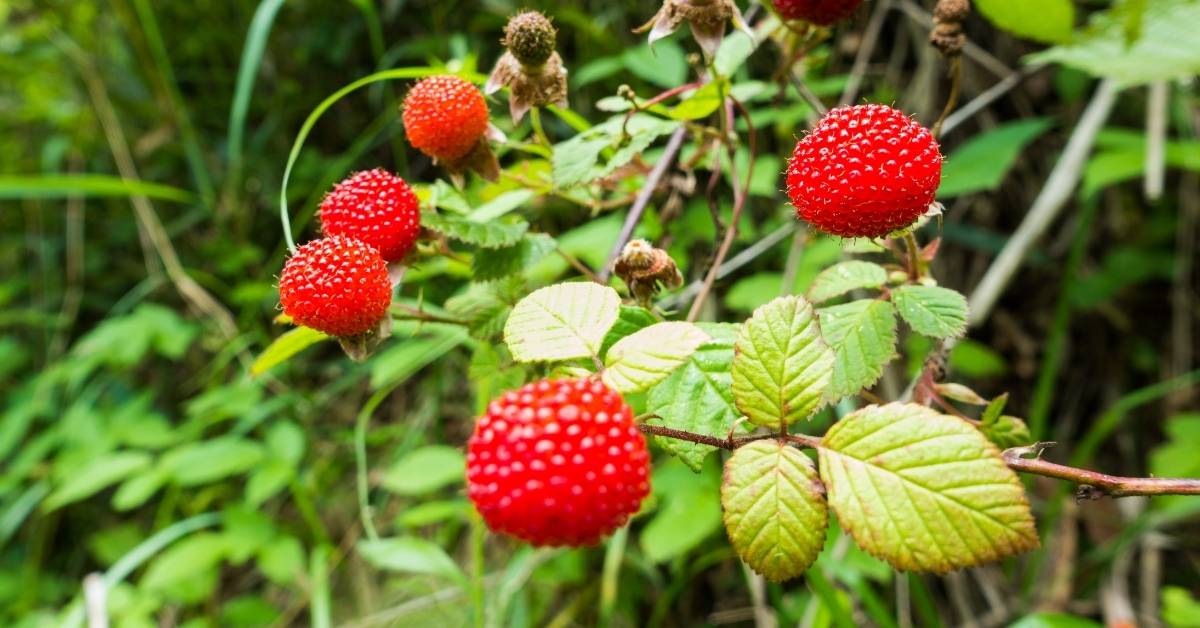
Description
Rubus idaeus, or red raspberry plants, are native to northern North America and Eurasia. Cultivated red raspberries have been grown in the United States since 1771.
Red raspberries produce new canes from buds on the roots and the crown. Canes are known as primocanes in their first year and floricanes in their second year. After the second year, the canes are trimmed out. During the growth season, both primocanes and floricanes are present.
Red raspberries come in two varieties. The first-year primocanes of floricane (summer fruiting) red raspberries are only vegetative. Early in the summer, the second-year floricanes produce a harvest. In the fall, primocane (fall fruiting) raspberries develop a large number of fruit at the top of the primocanes.
After fruiting, it’s easier to cut the primocanes to the ground in the winter. However, if you keep them for the second year, they will produce a crop on the floricanes the following summer. Because these primocane-fruiting types can be double-cropped, they sometimes are called everbearing raspberries.
Red Raspberry Cultivars
- Algonquin Red Raspberry
- Amity Red Raspberry
- August Red Raspberry
- Autumn Bliss Red Raspberry
- Autumn Britten Red Raspberry
- Boyne Red Raspberry
- Canby Red Raspberry
- Caroline Red Raspberry
- Cascade Bounty Red Raspberry
- Chemainus Red Raspberry
- Chilcotin Red Raspberry
- Citadel Red Raspberry
- Comet Red Raspberry
- Dinkum Red Raspberry
- Dorman Red Raspberry
- Double Delight Red Raspberry
- Durham Red Raspberry
- Encore Red Raspberry
- Fallred Red Raspberry
- Festival Red Raspberry
- Gatineau Red Raspberry
- Haida Red Raspberry
- Heritage Red Raspberry
- Hilton Red Raspberry
- Indian Summer Red Raspberry
- Jaclyn Red Raspberry
- K81-6 Red Raspberry
- Killarney Red Raspberry
- Latham Red Raspberry
- Lauren Red Raspberry
- Meeker Red Raspberry
- Newburgh Red Raspberry
- Nova Red Raspberry
- Polana Red Raspberry
- Prelude Red Raspberry
- Puyallup Red Raspberry
- Qualicum Red Raspberry
- Red River Red Raspberry
- Redwing Red Raspberry
- Regency Red Raspberry
- Reveille Red Raspberry
- Taylor Red Raspberry
- Titan Red Raspberry
- Tulameen Red Raspberry
- Willamette Red Raspberry
Cascade Bounty Raspberry Plant
Cascade Bounty red raspberry was released from the Washington State University, Oregon State University, University of Idaho, and the U.S. Department of Agri-Agriculture Research Service breeding program in 2005. It is a mid to late-season floricane cultivar and is very vigorous and high-yielding. It has also been shown to be hardy in cold climates.
Fruit is generally glossy, bright-colored, medium-sized, and round in shape. The firm fruit and released easily from the receptacle. The flavor of the fruit is tart and excellent.
Cascade Bounty fruit is great for the fresh market and is machine harvestable as long as the fruit isn’t used in IQF (Individual Quick Frozen).
The plant is extraordinarily tolerant to phytophthora root rot but is susceptible to RBDV (raspberry bushy dwarf virus).
Details
- Type: Floricane (Summer) Fruiting
- US Plant Patent: 18,246
- Designation: ‘Chief’ x WSU 994
- Height: 4-6 Feet
- Spacing: 3 Feet
- Depth: Same as they were at nursery
- Spread: 4 Feet
- Sun Level: Full or Part Sun
- Pollinator: Self-pollinating
- Color: Bright red
- Fruit: Medium-sized, round, firm
- Taste: Tart, excellent
Heritage Raspberry Plant
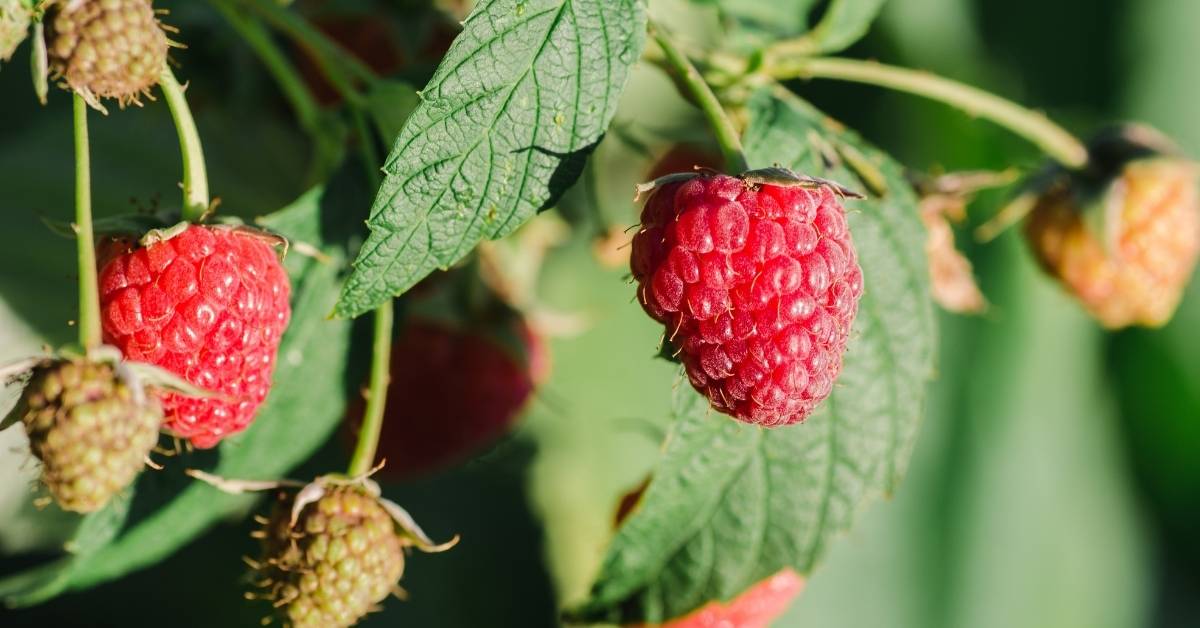
Heritage raspberry plants are a popular and easy raspberry cultivar to grow. It has been said to be the best everbearing raspberry plant on the market. It will generate a constant harvest of big vibrant red berries. Heritage raspberry is an everbearing raspberry cultivar and is also able to produce two crops per year.
Plants will bear fruit the first year. Berries will be produced in moderate quantities in early July and produce heavy quantities in late August through October. Plants are robust and vigorous, with very few thorns and fruit spread openly for easier harvesting.
Fruit is delicious and sweet with a large size and firm texture. Heritage raspberry won’t fall to pieces if you delay picking the ripe berries for one or two days. The fruit has a large number of seeds and may be used to produce jams, jellies, syrup, and juice. Raspberries will be rich in antioxidants, making them a delicious and nutritious snack.
Raspberries can be bought in a pot or bare root. Flowers have a pure white color and bloom before the leaves emerge. Wind and insects, especially bees, pollinate self-fertile flowers.
Flowers are a dusky pink with deeper bar and red anthers. Heritage raspberries plants are also self-fertile, eliminating the need for an additional pollinator cultivar. They are really tough to grow in heavy clay-based soils or in soils that stay wet.
Plants are perennial, with the roots living for many years, while the individual canes are biennial. Plants are incredibly vigorous and are usually resistant to diseases such as Powdery Mildew. Plants can survive in cold weather and are very robust.
Heritage raspberry is well-branched and extremely floriferous, providing many straight and strong stems. It does not need staking or trellising. Plants will take the sun but keep roots cool. It is prone to sunburn injury and must be irrigated intermittently if the temperature gets hot enough.
Details
- Type: Primocane (Fall) FruitingDesignation: (Milton x Cuthbert) x Durham (1969)
- Zones: 3-8 (-40F)
- Height: 5-6 Feet
- Spacing: 3-4 Feet
- Depth: Same as they were at nursery
- Spread: 4-5 Feet
- Sun Level: Full or Part Sun
- Pollinator: Self-pollinating
- Color: Dark red
- Fruit: Large, round, firm, juicy
- Fruit Size: Large fruit
- Taste: Mild, sweet
- Texture: Firm ripening
Tulameen Raspberry Plant
Tulameen Raspberry is a hardy and adaptable raspberry cultivar. It produces a high yield of a big, bright red fruit with a good sugar-acid balance and a clean, robust, sweet raspberry taste. It produces one of the biggest red raspberries with a beautiful look.
Tulameen raspberry plants thrive well in a home garden and are also commonly planted commercially. It has a 50-day ripening season and ripens in July.
Tulameen raspberry bushes produce tall canes with minimal spines. It was developed in Canada and had excellent weather and winter hardiness, but it requires a well-protected location.
Tulameen raspberries are delicious straight from the cane or in preserves and pies.
Details
- Type: Floricane – Produces fruit on second-year wood
- Zones: 4-7
- Height: 5-6 Feet
- Spacing: 2.5 Feet
- Sun Level: Full
- Color: Bright red
- Fruit Size: 4 grams
- Taste: Good, delicious
- Vigor: Medium
- Hardiness: Fully hardy
Boyne Raspberry Plant

Boyne Raspberry Plant is an early-season variety that is extremely winter hardy. It was released in 1960 and was developed in northern Minnesota. It consistently produces deep-red, medium-sized berries that are easy to pick. It generally produces fruit 10 days before the Latham raspberry cultivar.
It’s ideal for freezing and jamming, as well as eating fresh, because of its medium sweet, fragrant flavor. It will thrive in areas where other kinds’ canes have been damaged by winter.
At maturity, Boyne Raspberry will grow to be around 5 feet tall with a 4-foot spread. It has a leggy appearance, with a typical ground clearance of one foot. Boyne canes are upright and sturdy and will not need trellising to support the abundant fruit production.
It has a high growth rate and may expect to survive for around 10 years under optimum conditions. The mother plant produces a large number of suckers.
It prefers to grow in average to moist conditions and shouldn’t be allowed to dry out.
Details
- Type: Floricane (Summer) Fruiting
- Zones: 3-7
- Height: 5 Feet
- Spacing: 3-4 Feet
- Spread: 4 Feet
- Sun Level: Full
- Color: Dark red
- Fruit Size: Medium
- Fruit Shape: Long conic
- Taste: Excellent
- Texture: Firm
- Yield: High
Yellow-Gold Raspberry Plants
Description
Yellow raspberry plants or golden raspberry plants result from a genetic mutation of red raspberries. Most are primocane fruiting types and are similar to red raspberries in growing habit. Yellow raspberries are most often grown in the northern states and will produce best on sandy loam soils that are rich in nutrients.
Yellow Raspberry Cultivars (Golden Rapberry Plant)
- Anne Yellow Raspberry
- Season – Everbearing
- Fruit Size – Large
- Origin – Maryland
- USDA Zone – 4-9
- Fallgold yellow raspberry
- Season – Everbearing
- Fruit Size – Medium
- Origin – New York
- USDA Zone – 5-9
- Golden Harvest Yellow Raspberry
- Season – Everbearing
- Fruit Size – Large
- Origin – New York
- USDA Zone –
- Goldie Yellow Raspberry
- Season – Everbearing
- Fruit Size – Medium
- Origin – New York
- USDA Zone – 5-7
- Kiwi Gold Yellow Raspberry
- Season – Everbearing
- Fruit Size –
- Origin – New Zealand
- USDA Zone – 4-8
How to Grow Raspberries
It is best to grow these plants in either green houses or vegetable gardens. Fruit bearing is mainly done in two seasons; one is June-bearing and the other is fall-bearing.
The former crop bears fruit during the span of June and July. So, in a season, it generally has two harvests. For better yielding, it is highly important that it must be protected from too hot or too cold climatic condition. It tends to develop fungal infection when made to grow in damp soil.
For this reason, the spring and summer are regarded as the most suitable season for cultivation. Purchasing the type of plantlets has to be done according to the location. It is very important to select pest and disease resistant types for a steady growing tenure.
The essential factors in raspberry success are careful plant selection, a sturdy trellis structure, and regular care that is appropriate for the plant type. If you give it to your plant, it will provide you with decades of excellent fruit output and a lot of happiness.
Choosing your Variety
The procedures explained here are for a traditional everbearing variety known as ‘Summit.’ Ideally, you should inquire at your local greenhouse about which plants are most suited for your climatic zone, as well as rooted canes that are disease-free.
I went with an everbearing variety since it will produce more fruit: if you take good care of it, it will give you plenty of raspberries for cakes, gifts for your neighbors, frozen berries, and other uses.
Summer-bearing cultivars only produce fruit for approximately a month before dying. Summer-bearing cultivars start producing a few weeks earlier than everbearing types.
If you want to add some diversity to your garden, try planting a summer-bearing type like Brandywine or some yellow raspberries like “Golden” or “Fall Gold” and “Golden Harvest.”
The amount of plants
Raspberry plants are highly prolific, and even a single cane planted will almost certainly result in hundreds of fruit in a few years.
In terms of size, I recommend a two-tow strawberry patch that is 9 feet wide and at least 20 feet long. Allow 4 to 6 feet between tows to give yourself ample room to select fruits comfortably.
Root rot is a common problem with raspberry plants, and they eat a lot. Building a raised bed (about 20 inches high) with 4/5 garden topsoil with 1/5 sand, manure, and peat is a wonderful idea. Raspberries prefer acidic pH levels of approximately 6. This is an excellent time to do it since you’ll be ready to plant in the spring.
Of course, you may grow raspberries in your yard, but make sure the soil is deep and drains well; otherwise, the plants will succumb to root rot.
Also, avoid growing raspberries in the same spot where you previously planted tomatoes, potatoes, or peppers, since this may raise the danger of verticillium wilt.
Planting Raspberries
Early spring to late summer is the optimum time to grow raspberry plants (for summer planting, you will need a very healthy plant, though). If you plant them in the spring, you’ll usually receive your first harvest in the summer!
For six hours, immerse bare-root plants in a half-strength solution of vitamin B1 growth booster (1/2 teaspoon per quart water). After that, plant them as soon as possible (do not keep them in the solution for more than a day, and don’t wait too long to plant them, or they’ll perish).
After that, dig a 1-foot-deep, 1-foot-wide hole, fill it with well-rotted manure and organic fertilizer, or 4-20-20, and cover it with mulch to keep the moisture in.
Plants should be spaced 3 to 5 feet apart, with mulch no deeper than 3 inches. For each plant, dig a hole that is one foot deep and broad. In our situation, the plants were spaced 3 feet apart in a row. Fill the hole with a handful of rotting manure and fertilizer.
Add some water, then carefully tuck the dirt around and over the plant’s spread roots to create a tiny depression or basin at the surface, where rainwater may collect. Spread some additional rotten manure in this depression to help the plants grow faster, then mulch the area surrounding the plants to a depth of no more than 3 inches. We covered our route with landscape cloth and wood chips in between the rows.
Soil requirements
The soil bed needs to be well prepared in the early autumn to ensure better plantation technique. No matter what type of soil you choose to plant the plantlets, only proper attention should be given to the drainage system of the area. See to the fact that the pH value of the soil ranges from 5.5 to 7.
Raspberry Plant Care
Watering
Drip irrigation is the best method for watering raspberries.
Growing raspberry needs a regular supply of water which is mainly because of their shallow-root system. Some steps of the procedure bear resemblance to the procedure of how to grow strawberries.
The development of the canes takes place in the first year of raspberry plantation and is vegetative in nature. This has to be followed by its propagation by making use of appropriate techniques.
T-bar Trellises
If all goes according to plan, your raspberry bushes will produce so much fruit that they will require external support to avoid toppling over; at-bar really is the perfect tool for providing this support inexpensively and effectively.
1 foot in the earth, bury a 6-foot post, then secure 30-inch crossbars across the top and middle of each post with strong screws. Add two layers of wire, one 2 feet from the ground and the other stretching from each crossbar’s ends (a 16-gauge wire will do).
Pruning Raspberries
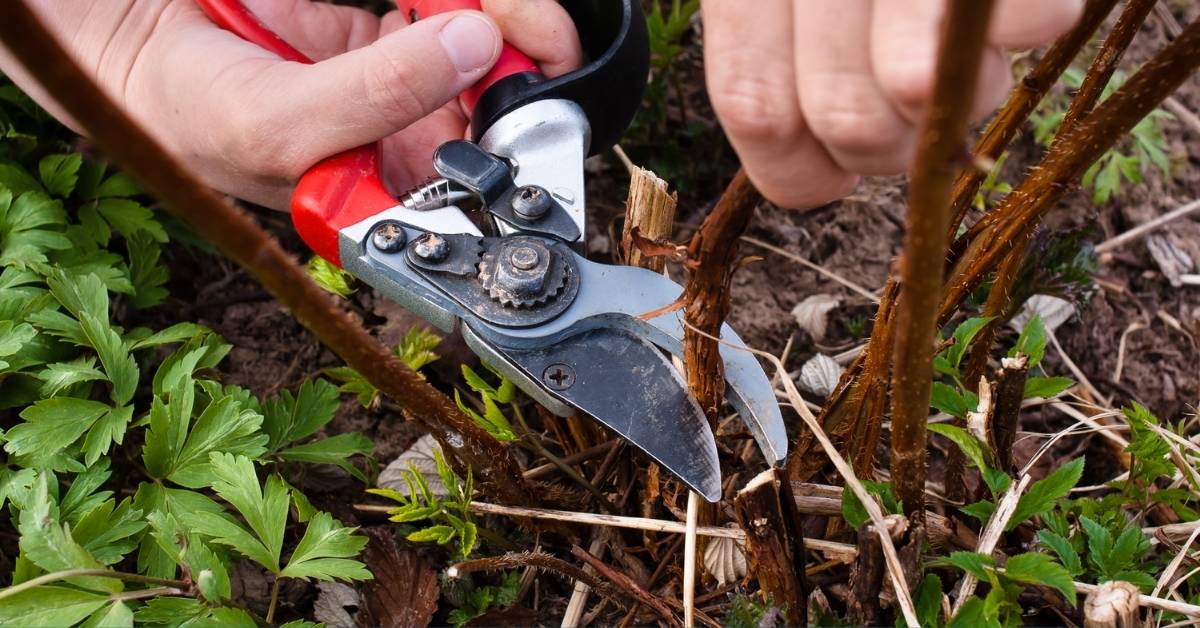
Pruning is the process of eliminating old, ineffective canes to make way for newer, healthier ones. Some of your young canes will begin to bear fruit at their apex in late summer and early fall. Wait until spring to trim these 1-year-old canes, keeping track of them.
Only trim them to just below the fruiting region (about level with the top support wire) since this will allow them to fruit in July and allow new primocanes to develop quickly between the old canes.
These primocanes will fruit in late summer, and their suckers should be removed (unless you want your entire garden to be covered in raspberries!).
Two-year-old canes should be fully removed to create a way for new ones in the second year (i.e., cut them at ground level), whereas one-year-old canes should be trimmed as stated above. More output may be ensured by applying well-rotted manure in the early spring.
Raspberry Pests and Diseases
A good rule of thumb for keeping your raspberry plants healthy is to keep them damp in the summer and dry in the winter: mulching heavily helps retain moisture at a reasonable level, and remember to water them with a drip system.
Raspberry plants also require a lot of nitrogen to reach their full potential (about 7 feet). Many gardeners use a lot of nitrogen, but I think it’s best to cut it off around fruiting time: too much nitrogen encourages the plants to develop leaves when you want them to produce fruit!
Although raspberries are often hardy and resistant to disease, they are susceptible to aphids, fruit worms, and nematodes. Maggots girdle the developing canes and snap them off at the soil level, posing another threat.
Raspberries are self-pollinating, but they will require the help of bees or other insects to do it, so look for a location with a beehive nearby.
Root rot (particularly frequent if you overwater), fruit rot, and spur blight are some of the other illnesses you may encounter. Fruit rot may be avoided by collecting fruit often during wet weather and lightly trimming the shrub.
At the first indication of warm weather, root rot causes the plant to die after blossoming.
Spur blight causes dark stains on primocanes from mid-summer to late fall when there is a lot of humidity. The most significant “treatment” here is prevention, which may be accomplished with a dormant spray of a lime-sulfur solution.
How to Store Raspberries
Storage is just as important as proper selection: your attention should be focused on removing any spoiled or molded berries, as they tend to contaminate the other healthy berries.
You can keep raspberries in the refrigerator for a couple of days. The correct way to store them is to remove spoilt berries, wash the rest thoroughly with water (paying attention not to damage them), then spread them on a plate and cover them with plastic wrap.
In general, the only way to store them is to either put them in the refrigerator or freeze them: raspberries spoil quickly at room temperature, especially if it’s hot and humid and they’re exposed to sunlight.
To freeze them, wash them with a sink sprayer (at the lowest pressure so as not to crush the berries) and dry them with a paper towel or napkin. Again, spread them on a plate, cover with plastic wrap and leave them in the freezer for 6-8 hours.
Frozen berries can withstand more mechanical pressure, so you can now remove them from the plate and put them in a plastic bag, back in the freezer. A common trick is to sprinkle lemon juice on them to prevent oxidation and keep a vibrant color.
Properly frozen, berries can last up to a year, especially if you add lemon juice.
Raspberry Nutrition Facts
Refuse: 4% (Caps, stems, and spoiled berries)
Scientific Name: Rubus spp.
NDB No: 09302 (Nutrient values and weights are for edible portion)
| Nutrient | Units | Value per 100 grams | Number of Data Points | Std. Error |
|---|---|---|---|---|
| Proximates | ||||
| Water | g | 85.75 | 14 | 0.99 |
| Energy | kcal | 52 | 0 | 0 |
| Energy | kJ | 220 | 0 | 0 |
| Protein | g | 1.20 | 12 | 0.097 |
| Total lipid (fat) | g | 0.65 | 11 | 0.263 |
| Ash | g | 0.46 | 12 | 0.06 |
| Carbohydrate, by difference | g | 11.94 | 0 | 0 |
| Fiber, total dietary | g | 6.5 | 13 | 0.657 |
| Sugars, total | g | 4.42 | 5 | 0.147 |
| Sucrose | g | 0.20 | 5 | 0 |
| Glucose (dextrose) | g | 1.86 | 5 | 0.068 |
| Fructose | g | 2.35 | 5 | 0.084 |
| Lactose | g | 0.00 | 5 | 0 |
| Maltose | g | 0.00 | 5 | 0 |
| Galactose | g | 0.00 | 5 | 0 |
| Starch | g | 0.00 | 4 | 0 |
| Minerals | ||||
| Calcium, Ca | mg | 25 | 11 | 1.3 |
| Iron, Fe | mg | 0.69 | 12 | 0.046 |
| Magnesium, Mg | mg | 22 | 12 | 2.19 |
| Phosphorus, P | mg | 29 | 11 | 2.779 |
| Potassium, K | mg | 151 | 12 | 20.32 |
| Sodium, Na | mg | 1 | 8 | 0.571 |
| Zinc, Zn | mg | 0.42 | 12 | 0.069 |
| Copper, Cu | mg | 0.090 | 12 | 0.019 |
| Manganese, Mn | mg | 0.670 | 11 | 0.152 |
| Selenium, Se | mcg | 0.2 | 2 | 0 |
| Vitamins | ||||
| Vitamin C, total ascorbic acid | mg | 26.2 | 10 | 5.588 |
| Thiamin | mg | 0.032 | 12 | 0.008 |
| Riboflavin | mg | 0.038 | 12 | 0.007 |
| Niacin | mg | 0.598 | 12 | 0.057 |
| Pantothenic acid | mg | 0.329 | 12 | 0.034 |
| Vitamin B-6 | mg | 0.055 | 12 | 0.007 |
| Folate, total | mcg | 21 | 12 | 5.894 |
| Folic acid | mcg | 0 | 0 | 0 |
| Folate, food | mcg | 21 | 12 | 5.894 |
| Folate, DFE | mcg_DFE | 21 | 0 | 0 |
| Choline, total | mg | 12.3 | 0 | 0 |
| Betaine | mg | 0.8 | 1 | 0 |
| Vitamin B-12 | mcg | 0.00 | 0 | 0 |
| Vitamin B-12, added | mcg | 0.00 | 0 | 0 |
| Vitamin A, RAE | mcg_RAE | 2 | 0 | 0 |
| Retinol | mcg | 0 | 0 | 0 |
| Carotene, beta | mcg | 12 | 16 | 8.03 |
| Carotene, alpha | mcg | 16 | 12 | 6.054 |
| Cryptoxanthin, beta | mcg | 0 | 12 | 0 |
| Vitamin A, IU | IU | 33 | 0 | 0 |
| Lycopene | mcg | 0 | 4 | 0 |
| Lutein + zeaxanthin | mcg | 136 | 4 | 2.179 |
| Vitamin E (alpha-tocopherol) | mg | 0.87 | 6 | 0.072 |
| Vitamin E, added | mg | 0.00 | 0 | 0 |
| Tocopherol, beta | mg | 0.06 | 6 | 0.01 |
| Tocopherol, gamma | mg | 1.42 | 6 | 0.141 |
| Tocopherol, delta | mg | 1.04 | 6 | 0.155 |
| Vitamin K (phylloquinone) | mcg | 7.8 | 6 | 0.553 |
| Lipids | ||||
| Fatty acids, total saturated | g | 0.019 | 0 | 0 |
| 4:0 | g | 0.000 | 0 | 0 |
| 6:0 | g | 0.000 | 0 | 0 |
| 8:0 | g | 0.000 | 0 | 0 |
| 10:0 | g | 0.000 | 0 | 0 |
| 12:0 | g | 0.000 | 0 | 0 |
| 14:0 | g | 0.000 | 0 | 0 |
| 16:0 | g | 0.016 | 2 | 0 |
| 18:0 | g | 0.004 | 2 | 0 |
| Fatty acids, total monounsaturated | g | 0.064 | 0 | 0 |
| 16:1 undifferentiated | g | 0.000 | 0 | 0 |
| 18:1 undifferentiated | g | 0.059 | 2 | 0 |
| 20:1 | g | 0.005 | 2 | 0 |
| 22:1 undifferentiated | g | 0.000 | 0 | 0 |
| Fatty acids, total polyunsaturated | g | 0.375 | 0 | 0 |
| 18:2 undifferentiated | g | 0.249 | 2 | 0 |
| 18:3 undifferentiated | g | 0.126 | 2 | 0 |
| 18:4 | g | 0.000 | 0 | 0 |
| 20:4 undifferentiated | g | 0.000 | 0 | 0 |
| 20:5 n-3 | g | 0.000 | 0 | 0 |
| 22:5 n-3 | g | 0.000 | 0 | 0 |
| 22:6 n-3 | g | 0.000 | 0 | 0 |
| Cholesterol | mg | 0 | 0 | 0 |
| Other | ||||
| Alcohol, ethyl | g | 0.0 | 0 | 0 |
| Caffeine | mg | 0 | 0 | 0 |
| Theobromine | mg | 0 | 0 | 0 |
Raspberry Organizations in the U.S.
A detailed listing of Raspberry Organizations to assist in raspberry plant research.
North America Raspberry & Blackberry Association (NARBA)
Website: North America Raspberry & Blackberry Association
The objectives of the North American Raspberry & Blackberry Association (NARBA) are “a) to promote the production and marketing of raspberries and blackberries in North America through communication, education, and research; b) to provide a unified voice to represent the bramble industry, and c) to promote blackberries and raspberries to the general public.”
United States (Click to Expand)
New York State Berry Growers’ Association (NYSBGA)
Website: New York State Berry Growers’ Association
The New York State Berry Growers Association (NYSBGA) was begun in 1988 and incorporated in 1994 in its present form, a 501 (6) (c) not-for-profit educational association. The association’s primary role is to provide information and education to its grower members and represent berry industry research needs to university and extension people. While the berry business does not have a dedicated lobbying organization, it can be represented in public hearings and government forums. The NYSBGA has a board of directors that meets three to four times a year and employs an executive secretary.
North Carolina Commercial Blackberry and Raspberry Growers Association (NCCBRGA)
Website: North Carolina Commercial Blackberry and Raspberry Growers Association
The NCCBRGA was developed in 2007 to help commercial Blackberry, and raspberry growers achieve higher-yielding, better quality crops through education from University and Industry specialists and interaction with other growers. The NCCBRGA also supports Blackberry and raspberry research in North Carolina.
Oregon Raspberry& Blackberry Commission (ORBC)
Website: Oregon Raspberry& Blackberry Commission (ORBC)
In 1981, the Oregon Raspberry & Blackberry Commission (ORBC) was formed. The Oregon Caneberry Commission was the name of the commission at the time. The commission changed its name in 1992 after years of public misunderstanding about the term “cranberry.”
Cranberries, such as raspberries, blackberries, Marionberries, and Boysenberries, are berries that grow on a cane. The commission consists of nine members: six growers, two packers, and one public member. Their primary focus is the promotion of cranberries. Strong secondary directions are research and education. The ORBC has over 550 growers in Oregon.
Southern Region Small Fruit Consortium
Website: Southern Region Small Fruit Consortium
The Consortium’s long-term mission is to bring together small fruit growers and grower organizations, industries, and service organizations allied with and/or to serve small fruit growers, agricultural extension programs, and research stations at various locations throughout the region to enhance the development of the region’s small fruit industries.
Washington Red Raspberry Commission (WRRC)
Website: Washington Red Raspberry Commission
The Washington Red Raspberry Commission (WRRC) was formed in 1976 to support and promote the raspberry industry. We are comprised of 11 grower board members who oversee programs that facilitate cultural and harvesting improvements and regulate unfair trade practices within the industry.
Wisconsin Berry Growers Association
Website: Wisconsin Berry Growers Association
The Wisconsin Berry Growers Association is dedicated to producing and promoting Wisconsin strawberries, raspberries, and blueberries.
British Columbia, Canada
Raspberry Industry Development Council (RIDC)
Website: Raspberry Industry Development Council
The Council’s mission is to promote raspberries and their usage by providing farmers with information and instructional services and connecting buyers of raspberry products with producers and processors. The Council also promotes raspberries to the general public and other interested parties by providing recipes and information about the business.
Manitoba
Prairie Fruit Growers Association
Website: Praire Fruit Growers Association
The Prairie Fruit Growers Association is a voluntary non-profit organization representing all Manitoba fruit crop growers.
Ontario Berry Growers Association (OBGA)
Website: Ontario Berry Growers Association
The Ontario Berry Growers Association is a provincial organization, which represents strawberry, raspberry, blueberry, currant, gooseberry, and other berry growers by funding industry promotion and research activities. All facets of the berry industry (wholesale, retail, pick-your-own, and roadside market) are represented by the Ontario Berry Growers Association.
